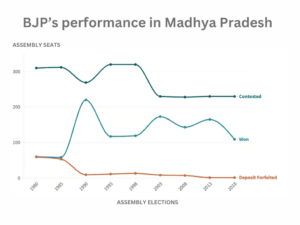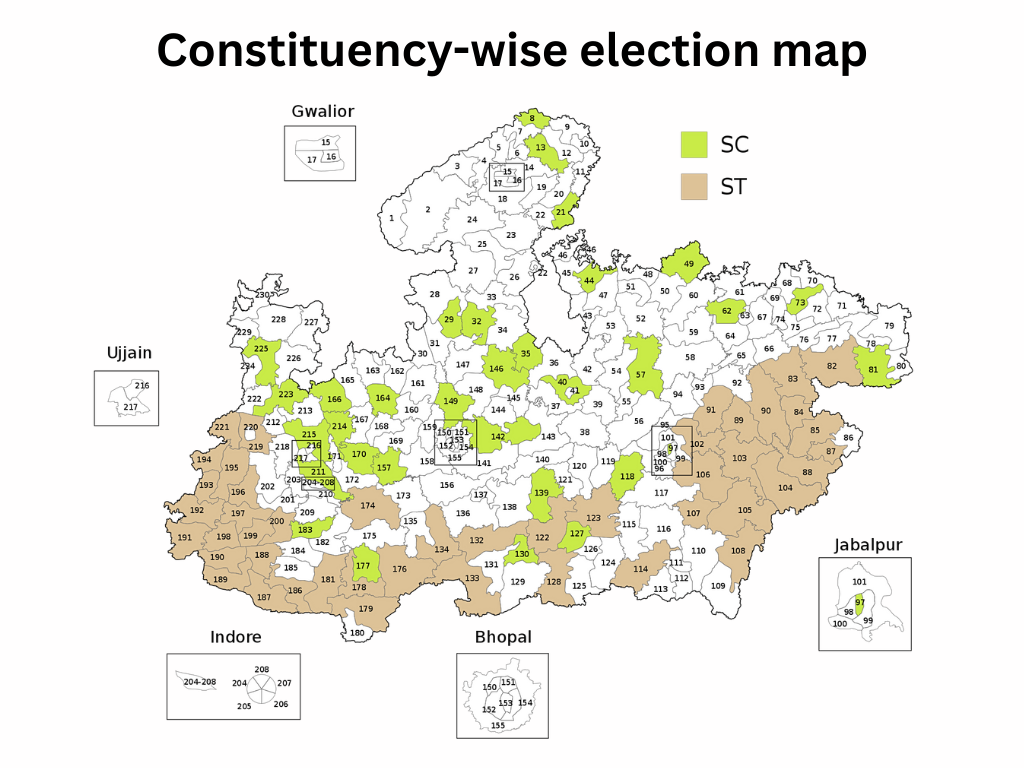The outcome of the Madhya Pradesh assembly election in December this year will set the narrative for the Lok Sabha elections in 2024. Significantly, the Bharatiya Janata Party (BJP) will battle anti-incumbency sentiments to retain the state, where it has been in power for almost 20 years.


At the heart of the challenge for the BJP, as an analysis of the numbers shows, is its fluctuating vote share in the Assembly elections since 1980. The recent surge in the Lok Sabha poll vote share has been attributed to Prime Minister Narendra Modi and the “Modi Factor” even as voter fatigue is a hurdle after almost two decades of uninterrupted rule. Barring a little over a year (December 2018 to March 2020), the party has been in power in MP from December 2003 and Chief Minister Shivraj Singh Chouhan has been at the helm since 2008.
The seriousness with which the BJP is taking the challenge of retaining power in MP is reflected in the decision this August to name candidates for 39 constituencies where it believes it is vulnerable. The last Assembly election, in 2018, threw up a fractured mandate. The state assembly, which came down from 320 seats to 230 after the bifurcation in 2000 requires a majority of 116 to form the government. The BJP won 109 seats, while the Congress, bolstered by certain independents managed to form the government with 114 seats.
However, CM Kamal Nath’s Congress government was short-lived after Jyotiraditya Scindia and a group of 21 MLAs switched to the BJP. The government fell after 15 short months.
BJP IN MADHYA PRADESH
Since its foundation in 1980, the BJP has contested nine Assembly elections in Madhya Pradesh (five in undivided MP and four after the state’s split in 2000).
Its best performance was in 1990, when it contested 312 seats and won 220 of them. The vote share stood at 46.5%. Its worst performance in terms of seats was in 2018, but the vote share remained at 41.33%. It was 45.19% in 2013.
While the BJP managed to return to power after the fall of Kamal Nath’s government in 2020, its 2018 numbers throw up questions. An analysis of BJP vote shares in MP Assembly elections between 1980 and 2018 shows that the party’s vote share in seats that it has contested has remained between 31.38% and 46.5%.
A distinct trend from an analysis of the vote shares from the mid-1990s: the BJP in Madhya Pradesh has been getting a higher vote share in the Lok Sabha polls which are held after the Assembly elections in the state.
The party got 38.82% votes in the 1993 Assembly elections. In the next Lok Sabha polls in 1996, the party obtained 41.32% of the votes in the state. After the 41.33% vote share in the 2018 Assembly polls, the party upped its game for the 2019 Lok Sabha polls and the vote share jumped to 58.23% just months later (see graph below).
This was even higher than 2014’s vote share of 54.76%. In absolute terms, the BJP secured 2.14 crore votes in 2019, which was higher than the total votes it polled (1.56 crore) in the 2018 Assembly elections.
A survey of 131 candidates announced by the BJP last week found that the party had fielded 117 male candidates and 14 women candidates. Of these, 44 belonged to the general category, 18 to Scheduled Tribes, 21 to Scheduled Castes and 38 to Other Backward Classes. Among these, significant caste sub-groups included: Brahmins (18), Rajputs (21), nine Gound candidates, seven from the Jain community, four Yadavs, and three Adivasis.
CONGRESS MANIFESTO
- OBC reservation: 27%
- Universal insurance cover: `25 lakh for all citizens
- Accidental cover: `10 lakh for all citizens
- Farm loans: up to `2 lakh
- Assistance to women: `1,500 monthly
- Youth unemployment allowance: `1,500 to ` 3,000 monthly for two years
- OTHER PROMISES
- LPG cylinders at `500
- Formation of state IPL team
- Free school education free
- Implementation of Old Pension Scheme






